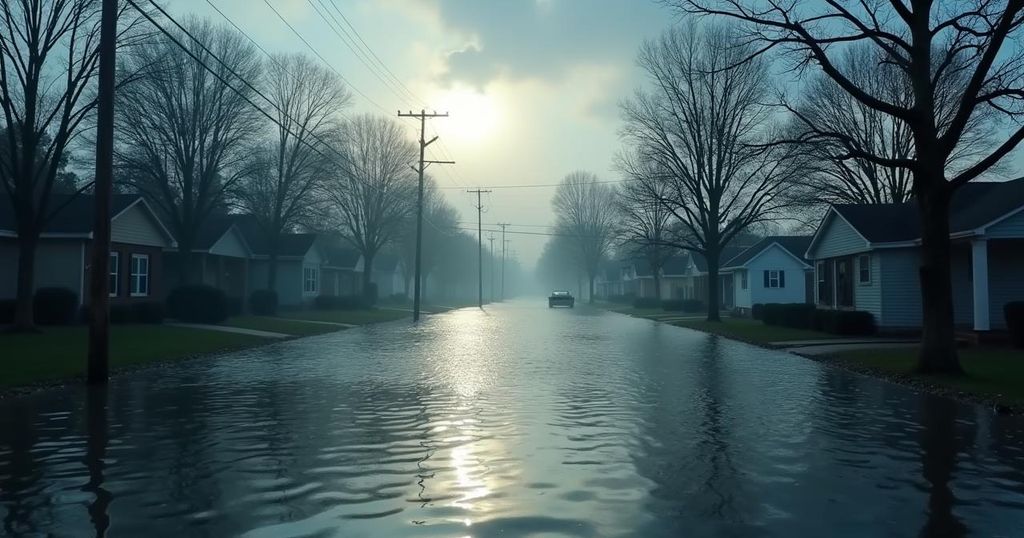Hurricane Helene: A Catastrophic Impact on North Carolina Towns

Hurricane Helene devastated towns in North Carolina, particularly Swannanoa, causing unprecedented flooding and displacing residents. With a rising death toll across five states and ongoing recovery efforts, officials face challenges including power outages and communication breakdowns. Community resilience and federal assistance are crucial as families await news of their loved ones and navigate the recovery process.
As Hurricane Helene decimated parts of North Carolina, towns including Swannanoa encountered unprecedented flooding, leaving residents in despair. Beverly and Baxter Eller, who had lived in their home for 37 years without incident, suddenly found themselves displaced after rising waters claimed their vehicles and threatened their safety. The couple expressed their anxiety, stating, “We haven’t cried yet… We are just in survival mode.” This catastrophe unfolded as the storm, originally a Category 4 hurricane, wreaked havoc across five states, leading to a rising death toll, with at least 49 fatalities reported as officials grappled with emergency calls and the missing persons crisis. In the aftermath, Buncombe County, which encompasses Asheville, seemed to bear the brunt of the storm’s wrath, prompting manager Avril Pinder to liken the situation to “Buncombe County’s own Hurricane Katrina.” Amidst these calamities, officials struggled to navigate extensive service outages as more than 700,000 residents lost power. Rescue operations encountered challenges, with over 150 rescues conducted by emergency responders; however, the situation remains dire with many still unaccounted for. Meteorologists have warned residents of ongoing flood risks, and cities like Asheville have implemented curfews amid rising fears of looting. President Biden assured that the federal government is actively responding and coordinating recovery efforts across affected areas. Described as “biblical devastation” by Buncombe County’s assistant emergency services director Ryan Cole, the scene revealed widespread destruction, as entire neighborhoods submerged and residents awaited news of their loved ones. Families across the Southeast, like Katie Cochran, anxiously sought information about relatives stranded without communication, highlighting the emotional toll of this disaster. As the region grapples with extreme rainfall and severe infrastructure damage, emergency protocols remain stringent as recovery efforts extend into difficult terrain. The wider impact of Helene’s devastation stretches even into urban areas such as Atlanta, marking a critical moment in response for communities caught in the storm’s path. As towns continue to assess the damage and recover from this disaster, the road to rebuilding will undoubtedly require significant resources and community resilience. In summary, Hurricane Helene left a significant mark on North Carolina and surrounding states, presenting both immediate challenges in rescue and recovery while prompting conversations about long-term rebuilding efforts and resources needed to restore normalcy in the lives affected by this natural disaster.
Hurricane Helene, which made landfall in late September 2024, significantly impacted the southeastern United States, particularly North Carolina. Classified initially as a powerful Category 4 storm, it wreaked havoc across several states, leading to devastating flooding, landslides, and widespread destruction of infrastructure. The storm emerged during a time when communities had previously experienced varying levels of hurricane threats, making the extent of Helene’s damage particularly shocking.
Hurricane Helene’s aftermath in North Carolina reveals the multifaceted challenges communities face following such disasters, including the ongoing struggle for rescue and recovery amidst widespread devastation. The rising death toll and emotional distress narrated a poignant reminder of the human impact of natural disasters. As local, state, and federal resources mobilize, the focus on recovery efforts indicates the determined resilience of those affected, with the hope that these communities will rebuild from this tragic devastation.
Original Source: www.washingtonpost.com




